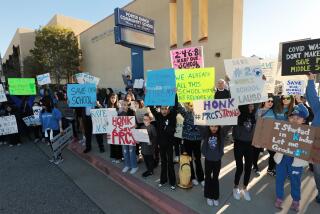Study Slams LAUSD Grad Rates
FOUR-PART SERIES: The Times examines why so many students drastically limit their prospects by dropping out of high school.
Graduation rates at Los Angeles schools rank among the worst of large, urban school systems, according to a sweeping national study released today.
The findings, which school district officials angrily rejected, will certainly add fuel to the heated debate surrounding Mayor Antonio Villaraigosa’s campaign to take control of Los Angeles Unified School District.
Slightly more than 44% of students in the Los Angeles Unified School District graduated from high school in four years, according to the study, which was conducted by the research arm of the nonpartisan publication Education Week. Of the country’s 50 largest public school districts, only five placed lower than Los Angeles, the study determined.
(State education officials noted that the 727,000-student L.A. Unified is saddled with far more students than all other districts except New York City and must contend with challenges such as its high rate of non-native English speakers.)
The troubling conclusions echoed those of similar studies in recent years. The most influential — by the Civil Rights Project at Harvard University and UCLA — calculated the graduation rate at 48% and has been used repeatedly by Villaraigosa to criticize the elected Board of Education that runs the district.
For all of California, today’s report pegged the graduation rate at 71%, which narrowly outpaced the average for all states. The study also reflected a wide, persistent achievement gap along racial lines, finding that in California and throughout the country far fewer African American and Latino students graduate on time than their white and Asian peers.
State education officials cautioned that the type of formula used to arrive at these controversial graduation rates are imperfect, namely because they rely on raw enrollment figures and do not account for students who withdraw and earn diplomas elsewhere.
Until states implement tracking systems that keep tabs on individual students, however, today’s estimate likely comes as close as possible, said Keric Ashley, director of data management for the California Department of Education. California is in the process of developing such a system.
Nonetheless, L.A. Unified officials blasted the report. Robert Collins, chief instructional officer for the district’s secondary schools, called it “horrifically flawed” and “unfair” because of the methodology researchers used.
Collins and Supt. Roy Romer both questioned the report’s use of enrollment data from the 2002-2003 school year, saying the district has made strides in recent years to increase the number of students who earn a diploma and to improve recordkeeping in the sprawling district.
“We’re making real gains in this. We’re keeping kids in longer, but we’re also getting more accurate information,” Romer said.
“They use information and it’s only good as the information that we collect. I’m finding our district doesn’t [collect] the information well,” he added.
Romer emphasized that L.A. Unified is no different than other large school systems struggling with high dropout rates.
“Urban districts have a terrible problem on this, no doubt about it. New York has it. We have it. Chicago has it. We know that, and that’s why we’re working on it so hard.”
The Education Week study found that New York City has a graduation rate of 39% and put Chicago, the nation’s third largest district, at 52%.
The superintendent reiterated claims that improving education in high schools and stemming the flow of dropouts is a top priority, saying, “We’re going to go after this with hammers.”
He attributed much of the problem to the anonymity students often encounter in the city’s large, overcrowded schools. The district’s uneven efforts to divide campuses into smaller, more personalized schools and an ambitious construction program, he said, would eventually make an impact.
“We’re more overcrowded than any district in the nation,” Romer said. “We’re curing that slowly. We’ve got things in motion to cure this problem. We’re in transit.”
Times staff writer Duke Helfand contributed to this report.
More to Read
Start your day right
Sign up for Essential California for news, features and recommendations from the L.A. Times and beyond in your inbox six days a week.
You may occasionally receive promotional content from the Los Angeles Times.







